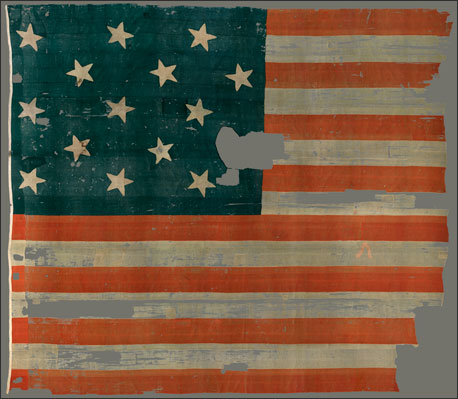Francis Scott Key was born on August 1, 1779 in Terra Rubra, Maryland. After graduating college, Key began to study law in hopes of becoming an attorney.1 Soon after, Keys got married and had eleven children and moved to Georgetown where he started his own practice.2 Key became very successful in his work as a lawyer, and for hobbies he sang for the church and wrote poems, a lot of which are still appreciated today. When the War of 1812 broke out, Key enlisted in the US army.3

Francis Scott Key was sent to a British ship to negotiate the release of certain prisoners. Upon Key’s arrival to the ship, he showed the Commodore of the ship letters from British troops that had been captured by American forces.4 The letters explained how well they were being treated and that they were not harmed in any way. After seeing this, the Commodore let their prisoner William Beanes free, but before the three American men could leave, the British troops were preparing to attack Fort McHenry, and therefore needed to keep them on the ship so that they would not be able to return back to warn the American troops.5
For over twenty-four hours the two sides, American and British, exchanged fire. The British recorded that “over eight hundred shells” were shot at the fort.6 After twenty-four hours of fighting both on land and sea, Francis Scott Key waited for the smoke to clear and saw that the American flag at Fort McHenry was still waving high. Key immediately began to write a poem on what he had witnessed that day. The poem quickly rose to fame and gained the attention of almost every single American.7
Very few people know that the poem went through different phases before becoming the American National Anthem. The original title of the poem was “The Defense of Fort McHenry.” Key later added the tune from an old drinking song called “To Anacreon in Heaven.”8 Later, Congress met to decide on a song for the nation; all songs were rejected, including “The Defense on Fort McHenry.” People that opposed the song claimed that the lyrics were too difficult to sing, it was not martial enough, and it was only about one event in all of American history.9 People who supported the song loved that the lyrics were difficult; that way only professional musicians and singers could sing it before certain important occasions.10
It was not until 1916 that the United States made the “The Star-Spangled Banner” the unofficial nation anthem. Woodrow Wilson was asked to have a “ceremonial song” for the United States, so he picked the most loved song by the people of the United States.11 But it was not until 1931 that Congress adopted the “The Star-Spangled Banner” as the official nation anthem of America. The poem was seen and adored by Americans for the patriotism it stood for and as a reminder of its past victories. This song is now sung before almost every major event in the United States to serve as a reminder of America’s victory against all odds.12
While the first stanza of the poem is widely known and sung today, few have been able to appreciate it in its entirety. Here, then, is the original poem:
O say can you see, by the dawn’s early light,
What so proudly we hail’d at the twilight’s last gleaming,
Whose broad stripes and bright stars through the perilous fight
O’er the ramparts we watch’d were so gallantly streaming?
And the rocket’s red glare, the bomb bursting in air,
Gave proof through the night that our flag was still there,
O say does that star-spangled banner yet wave
O’er the land of the free and the home of the brave?
On the shore dimly seen through the mists of the deep
Where the foe’s haughty host in dread silence reposes,
What is that which the breeze, o’er the towering steep,
As it fitfully blows, half conceals, half discloses?
Now it catches the gleam of the morning’s first beam,
In full glory reflected now shines in the stream,
‘Tis the star-spangled banner – O long may it wave
O’er the land of the free and the home of the brave!
And where is that band who so vauntingly swore,
That the havoc of war and the battle’s confusion
A home and a Country should leave us no more?
Their blood has wash’d out their foul footstep’s pollution.
No refuge could save the hireling and slave
From the terror of flight or the gloom of the grave,
And the star-spangled banner in triumph doth wave
O’er the land of the free and the home of the brave.
O thus be it ever when freemen shall stand
Between their lov’d home and the war’s desolation!
Blest with vict’ry and peace may the heav’n rescued land
Praise the power that hath made and preserv’d us a nation!
Then conquer we must, when our cause it is just,
And this be our motto – “In God is our trust,”
And the star-spangled banner in triumph shall wave
O’er the land of the free and the home of the brave.13
- War of 1812, 2002, s.v. “Key, Francis Scott.” ↵
- War of 1812, 2002, s.v. “Key, Francis Scott.” ↵
- War of 1812, 2002, s.v. “Key, Francis Scott.” ↵
- War of 1812, 2002, s.v. “Key, Francis Scott.” ↵
- UXL Encyclopedia of U.S. History, 2009, s.v. “The Star-Spangled Banner,” by Sonia Benson, Daniel E. Brannen, Jr., and Rebecca Valentine. ↵
- UXL Encyclopedia of U.S. History, 2009, s.v. “The Star-Spangled Banner,” by Sonia Benson, Daniel E. Brannen, Jr., and Rebecca Valentine. ↵
- UXL Encyclopedia of U.S. History, 2009, s.v. “The Star-Spangled Banner,” by Sonia Benson, Daniel E. Brannen, Jr., and Rebecca Valentine. ↵
- “Key, Francis Scott,” in Shaping of America, 1783-1815 Reference Library, edited by Lawrence W. Baker, Richard C. Hanes, Sharon M. Hanes, and Kelly Rudd, Vol. 2, Biographies Volume 1, 257. ↵
- “Key, Francis Scott,” in Shaping of America, 1783-1815 Reference Library, edited by Lawrence W. Baker, Richard C. Hanes, Sharon M. Hanes, and Kelly Rudd, Vol. 2, Biographies Volume 1, 258. ↵
- “Key, Francis Scott.” In Shaping of America, 1783-1815 Reference Library, edited by Lawrence W. Baker, Richard C. Hanes, Sharon M. Hanes, and Kelly Rudd, . Vol. 2, Biographies Volume 1,258. ↵
- “Key, Francis Scott.” In Shaping of America, 1783-1815 Reference Library, edited by Lawrence W. Baker, Richard C. Hanes, Sharon M. Hanes, and Kelly Rudd, Vol. 2, Biographies Volume 1,258. ↵
- UXL Encyclopedia of U.S. History, 2009 s.v. “The Star-Spangled Banner,” by Benson, Sonia, Daniel E. Brannen, Jr., and Rebecca Valentine. ↵
- Francis Scott Key, “The Star-Spangled Banner” (wording of the original handwritten manuscript, in the Museum Department of the Maryland Historical Society). ↵



101 comments
Fumei Pinger
I liked the fact the Woodrow Wilson picked this song based on the sole reason that it was “the most loved song by the people of the United States”, democracy at its finest. I like learning interesting facts about the United States, the root of our National Anthem being one of them. I liked that Francis Key adapted his poem to the tune of an old drinking song.
Maria Mancha
This past Christmas break I actually had the opportunity to go to Fort McHenry, I really enjoyed it. I learned a lot of information I didnt know before. I think its so cool that he wrote the star spangled banner and went to War for his country. Francis Key Scott in the middle of a war was able to think these poetic words that is heard all over the United States for numerous reasons and occasions. I enjoyed how you showed the original poem, it helped set up the story and the emotion Scott felt. Scott is an American hero and inspiration of patriotism.
Maria Esquivel
I absolutely loved reading your article. I know about Francis Scott Key and the Star-Spangled Banner but I didn’t know exactly how it originated. I found it really interesting how Francis was motivated to write such a beautiful poem. I also found it interesting how the poem had different titles before it became the ‘Star-Spangled Banner.’ Overall, I really enjoyed reading your article and I appreciate how you added the original poem.
Marlene Lozano
It was interesting to find out the history of The Star-Spangled Banner and have it originated. I had known that it had started with a poem and had changed over the years. This article gave great detail about Francis Scott Key and the history of how The Star-Spangled Banner became the official song of the United States. Overall this is a great article.
Christopher King
I enjoy this article just as any other true American should. The Battle at Fort McHenry was definitely a rough battle that the Americans showed how they can withstand just about anything. To think that the national anthem had almost became something completely different because they believed the lyrics were too difficult blows my mind. I liked this article because it shows the insipriation and the American spirit behind out national anthem that we all sing proudly at every special occasion.
Grady Purcell
Francis Scott Key’s name is a name that will never be forgotten he wrote the nations song that is played and sung everywhere. This song has a very deep-felt meaning and it brings warmth to your heart knowing that the brave American’s who came before us fought so heroically and vigorously just to keep this nation safe and protected from enemies. My dad is a former military man and with that being said he taught me to love and care for this banner because people risked their lives so we could live freely.
Destiny Flores
Living in the States, the United States Flag is something that is seen everywhere. We take much pride in our iconic representation. To learn more of where our anthem came from is very intriguing. Especially learning that there is more than the first stanza, which is just what were used to hearing. It makes the flag, and the anthem, that much more meaningful.
Samuel Ruiz
I remember learning this story in summary during my eighth-grade history class. I enjoyed this article and learning how the poem was actually rejected by Congress at first. I especially loved that the original poem in its entirety was included in the article. It was nice to read the pieces that are not very famous or included in the current national anthem.
Reese Lujan
The Star-Spangled Banner has always had a lot of meaning to me and my family with the military background that we have. I always wondered who came up with the lyrics to the star spangled banner. Francis Scott is truly an amazing patriotic icon to this world for creating this song and being proud to be an American of the United States.
Maricela Guerra
As I was reading this article, I did already know how the song came to be and the fact that where it was written and how was written. However what I didn’t know was the fact that it was rejected and that it had a different name at the time. When I read that some of the people were having trouble understanding the lyrics puzzled me, because I felt that even if the lyrics were sort of flat out it still made sense in a way that I guess professional artists did understand.